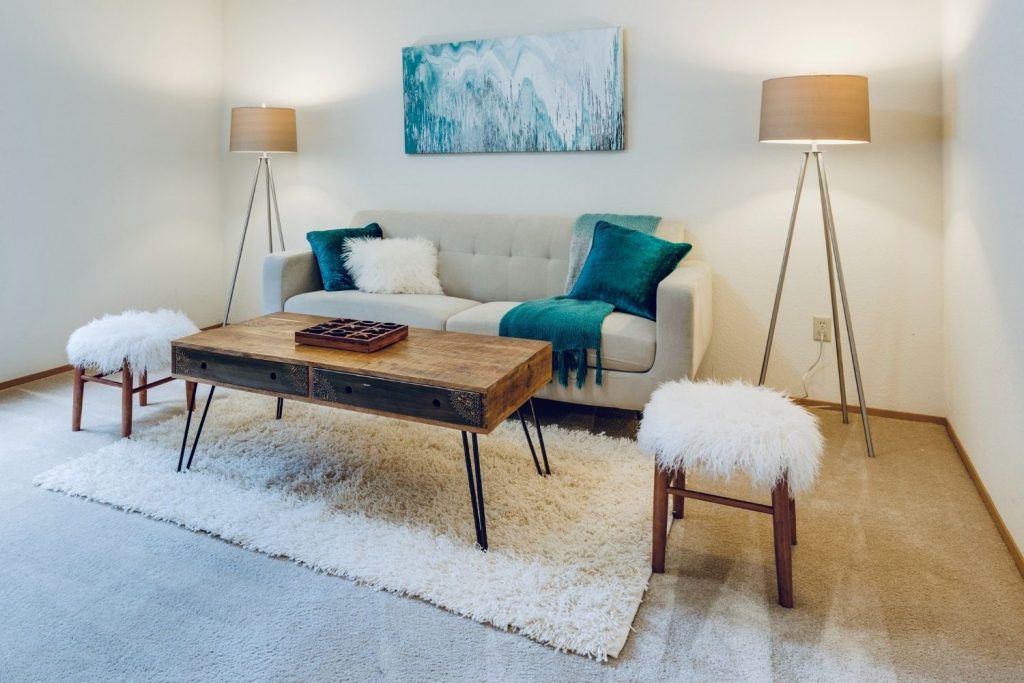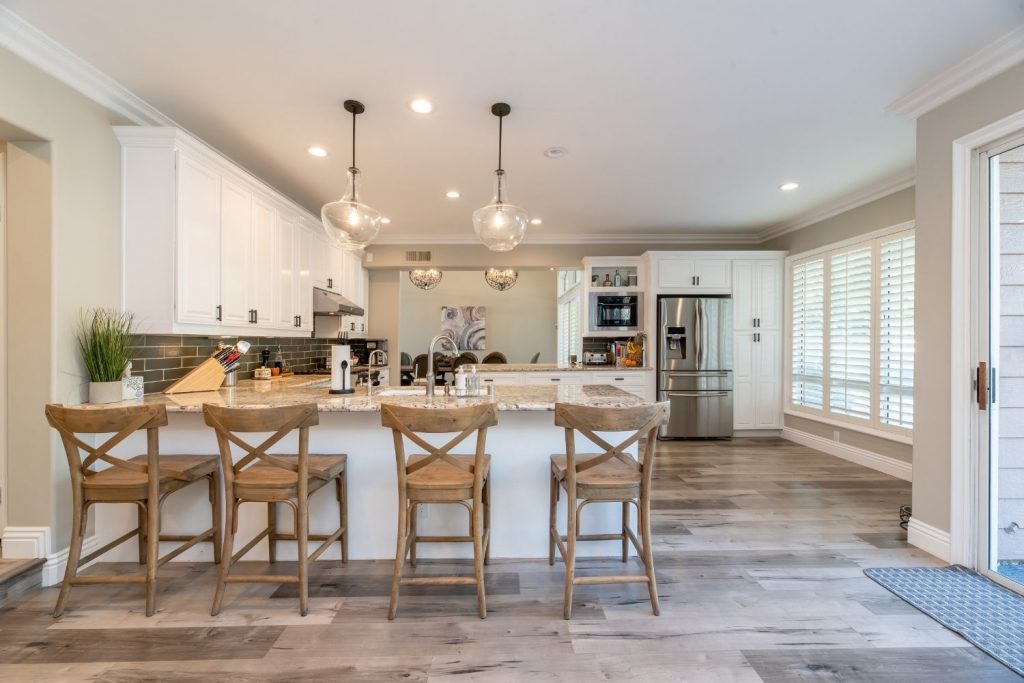Wondering how to choose an Interior Design color palette for your home — WITHOUT losing your mind?
Choosing colors is decidedly one of the most important aspects of Interior Design, which can make the process a little daunting for homeowners.
Whether you’re simply re-painting the master bedroom or giving the entire house a makeover, choosing the color scheme is likely going to be one of the first things you do, because little else will make sense until you have made that decision.
Feeling the pressure yet? Don’t worry, there are a lot of ways to choose the colors for your home, and it ultimately comes down to personal preference.
But if you’re feeling completely overwhelmed when it comes to selecting an interior paint color palette, take a deep breath — that’s what I’m here for. I’m going to help you simplify the process so that you can confidently choose colors for any room in your home.
Let’s get started and figure out your color scheme, so you can move right along with the remaining details.

This post may contain affiliate links and we may earn commissions when you click on the links at no additional cost to you. See our disclosure policy for more details.
How to Choose an Interior Design Color Palette
Let’s jump right into my top tips for choosing an Interior Design color scheme. Then, if you want to read more, we’ll dive in a little deeper.
- Choose one of the six main color schemes. They are: monochromatic, complementary, analogous, triad, split complementary, and tetradic.
- Look to nature for inspiration. The colors of the sunset or the hues you see at the beach are great ways to bring the outdoors in!
- Rock a neutral color scheme. Get creative with neutrals, and bring in pops of color where it makes sense.
- Consider various Interior Design “rules”. For example, the Rule of Three states that “things arranged in odd numbers are more visually appealing to the human eye.”
- Start with an inspiration piece. Fun fact: This is my preferred method! You can pull your color scheme directly from your chosen item, whether that’s a rug, artwork, or whatever.
Still not sure exactly where to get started? Let’s discuss these ideas in a little more depth, and hopefully you’ll find just what you’re looking for.
Color Theory & The Color Wheel
The first step in choosing a color palette is understanding the basics of color theory in Interior Design. The color wheel is a simple tool that can help you understand which hues go together.
You probably remember learning about it in High School art class, but let me give you a quick refresher:
Overview of the Color Wheel
We see color based on how light reflects off of a surface. The segments of the color wheel represent the science behind color, and show how colors relate to each other.
The color wheel is made up of twelve basic hues:
- Primary – red, yellow, blue
- Secondary – orange, green, purple
- Tertiary – red-orange, yellow-orange, yellow-green, blue-green, blue-purple, red-purple

Color Terminology
You might run across some of these terms later on, so here’s a quick overview to help clarify:
Hue = color
Tint = when white is added to a hue
Shade = when black is added to a hue
Light Reflectance Value (LRV) = measures the percentage of light a paint color reflects
Color scheme = the framework of how the colors are chosen and put together
Color palette = the specific colors that you’ve chosen
Warm color = yellow, orange, red
Cool color = blue, purple, green
(Color scheme and color palette are often used interchangeably, but a “palette” is more specific, and includes the actual names, such as paint colors.)
Types of Color Schemes
There are six main types of color schemes or palettes:
- Monochromatic: varying shades and tints of one color
- Complementary: two colors that are opposite each other on the color wheel
- Analogous: three colors that are adjacent to each other
- Triad: three colors that are evenly spaced around the color wheel
- Split-complementary: one color is chosen, plus the two that are on either side of its complementary color
- Tetradic: two sets of complementary colors
Grab a copy of How to Choose Paint Colors With Confidence, a printable workbook, and I will walk you through the five steps to choosing your perfect paint colors. You’ll also receive a bonus page on deciphering white paint undertones.
Where to Look for Inspiration Around You
Having a basic understanding of color theory now, you might notice the different types of color schemes everywhere you look. Yes, even in nature!
Look outside for color inspiration:
- the vibrant sunset
- warm, earthy hues
- calming ocean colors
Of course, stick with colors you love. If you aren’t sure what they are, look at your closet. What colors do you lean toward with your wardrobe?
Color inspiration is all around you. If nothing else, open up a home decorating magazine and start cutting out images that you’re drawn to, or follow our Pinterest account for ideas on how to choose an Interior Design color palette.
Ways to Rock a Neutral Color Scheme
Do you lean more toward neutrals? The good news is that you can still create an interesting home interior, even without much color.
In recent years, grays and all-white interiors have been trendy. However, in the next couple of years, we’ll be heading into warmer neutral territory (warm, caramel-y browns, for example).
Does that mean you should avoid gray or white as the main color in your home? Not at all! Again, stick with colors you love.
In fact, I recently painted my dining room in Clare Paint’s “Seize the Gray” — the perfect neutral. This light, fresh gray has “minimal undertones and provides a versatile backdrop for whatever the day may bring”.

If you like gray, but want a warmer vibe, look for grays with warm undertones — or even greige, which is a blend of gray and beige.
Get Creative With Neutral Colors
Whether you decorate in whites, grays, beige, black, or something in-between, you CAN create an interesting look by adding pattern and texture.
Think: shag rug, woven throw, satin pillows, patterned wallpaper….
Additionally, consider adding contrast with light and dark neutrals, such as charcoal and white, or creating a monochromatic color scheme with varying tints and shades of the same neutral hue.
Pro Designer Tip: Dark neutral colors typically look best with light neutrals that have the same undertones (or the same color temperatures) like warm with warm and cool with cool.
Add Pops of Accent Colors in a Neutral Room
Adding accent colors in smaller “pops” is a safe way to add interest to a neutral scheme.
If you’re making over your entire house, you can get a cohesive look by using a coordinating neutral color palette throughout the entire house. Then, simply add different accent colors to each room.
Another idea is to use the same accent color throughout the house, but in varying amounts. Or, you could use one color as the accent in one room, then take it into the next room and use it as the main color.
In the below photo, you can see how the designer created interest in a neutral room by adding lots of texture, as well as a few bursts of teal:

Following the “Rules” of Interior Design
How many different colors should you use in your home? How much of each hue? Let’s break down a couple of “rules” that might help answer those questions for those of you who are wondering how to choose a color palette that you’ll love.
Rule of Three
The rule of three simple states that “things arranged in odd numbers are more visually appealing to the human eye.”
This is why color palettes often consist of three different colors, or we tend to arrange items in groups of three. Our brains love odd numbers because they challenge us mentally, and groupings of three look more natural to us.
If you’re not sure how many colors to start with when selecting your color scheme, three is a great choice. You can always add different shades or tints of those hues later on.
Rule of 60-30-10
The rule of 60-30-10 is a timeless decorating guideline that can help you to easily put together a color scheme.
The 60 percent + 30 percent + 10 percent proportion is meant to give balance to the colors used in any space (source).
The 60 percent is your main color, and it’s going to serve as the anchor for what comes next.
You might use this color on:
- walls
- large accent pieces
- a larger piece of furniture
The 30 percent is your secondary color. So, you’re going to use this hue only half as much as the primary:
- draperies
- accent chairs
- bed linens
- painted furniture
- an accent wall
And, finally, the 10 percent is your accent color. It will occur in smaller “pops” around a room:
- throw pillows
- decorative accessories
- artwork
- bedside lamps
- candles
As you can see, this concept is incredibly simple to implement!
Tips to Choose Your Interior Paint Color Palette
Hopefully by now you’ve chosen a color scheme, settled on the furnishings, and now you’re ready to select your interior paint color palette.
The reason it’s so important to CHOOSE WALL COLOR LAST is because your paint options are virtually endless. It’s incredibly simple to customize your wall color to fit any type of decor.
It’s not always so easy to find decor that looks good with a paint color once it’s already on the wall.
Let’s take a look at a few other things to consider when choosing your wall colors:
- Pull your paint color from a print, artwork, or from the largest pattern in the space.
- If you like a color, but it’s not quite right in your space, try a lighter or darker shade.
- Pay attention to lighting (this is huge!) and “sight lines” — or, how it looks from various locations, including other rooms.
Sample Paint Colors Before Committing
If you don’t want to waste your time and money, this one is pretty important. Because, let’s face it, paint isn’t cheap, and it takes a good chunk of time to paint even a couple walls.
Plus, it’s so easy and inexpensive to try out some samples before committing, why wouldn’t you want to test them first?
Most paint stores offer small cans of sample paint, or even large stick-on samples that you can put right up on your wall. They give you a real-life representation of what it’ll look like once painted.
I promise, you won’t regret trying it out first.
Pro Designer Tip: Buying your paint from PPG, Sherwin-Williams, Benjamin Moore, or Farrow & Ball? Then you’ll want to check this out! You can order 12″x12″ stick-on samples (made with actual paint) from Samplize right from the comfort of your own home.
Use code FIRSTFIVE for a discount on your first Samplize order!
Additional (Often-Overlooked) Considerations
Before we conclude this piece, I wanted to share a few more things you might want to consider when choosing your interior color palette. These things are often overlooked, but could mean the difference between a space you love and one that’s just…okay.
Think about your mood.
Different colors evoke different feelings, so it’s important to consider how you want to feel when you enter a room.
For example, you probably want to feel relaxed when you enter your bedroom each night.
So it makes sense that you’d want to decorate it in colors that help you feel relaxed and promote sleep, rather than those that make you feel energized and awake.
When it comes to Interior Design, color psychology is a real thing!
Different colors evoke different feelings, so when choosing a color palette, it's important to consider how you want to feel when you enter a room.Click To TweetMake small spaces pop.
It seems that everyone recommends using white in a small room to help make it look bigger, but I’m here to tell you that you do NOT have to follow that advice.
In fact, sometimes bold colors actually look better in a small space. Just imagine lime green all over your living room! By limiting it to a smaller room, such as the entryway, you can still get a nice burst of color without getting overwhelmed.
Decorate from dark to light, vertically.
If you’re not sure where to use each color in your palette, a good rule of thumb is to start with dark at the floor level and go lighter as you move upward.
You’re essentially replicating the outside world and creating balance by keeping the darker, “heavier” colors grounded.
You can see this method put into practice in this beautiful, neutral kitchen:

Interior Design Color Schemes
Now that you know how to choose a color palette for any room in your home, it’s time to get to work! What interior paint color palette are you going with? Let us know in the comments.
You Might Also Enjoy:
How to Choose a Wall Color That You Won’t Instantly Regret
5 Great Options for a Whole House Color Palette from Benjamin Moore
5 Ideas for Your Whole House Color Palette from Sherwin Williams


I didn’t know you had to choose the wall colour last, I probably would have chosen that first if I hadn’t read this! Thanks for the tips!
I totally understand that — I’ve honestly done it before, but it’s so much easier if you wait until last to choose paint color!
Very useful
I loved the tip you shared about sticking with colors that you love. I’m hoping that I can get some new home decor pieces for my living room sometime this summer. I love cranberry, so I’m hoping I can incorporate that color.